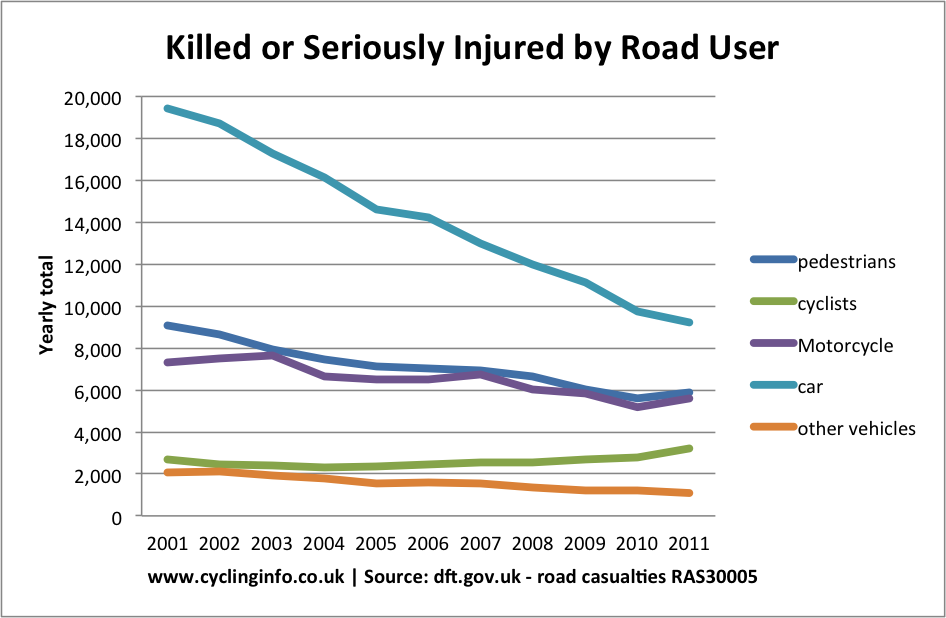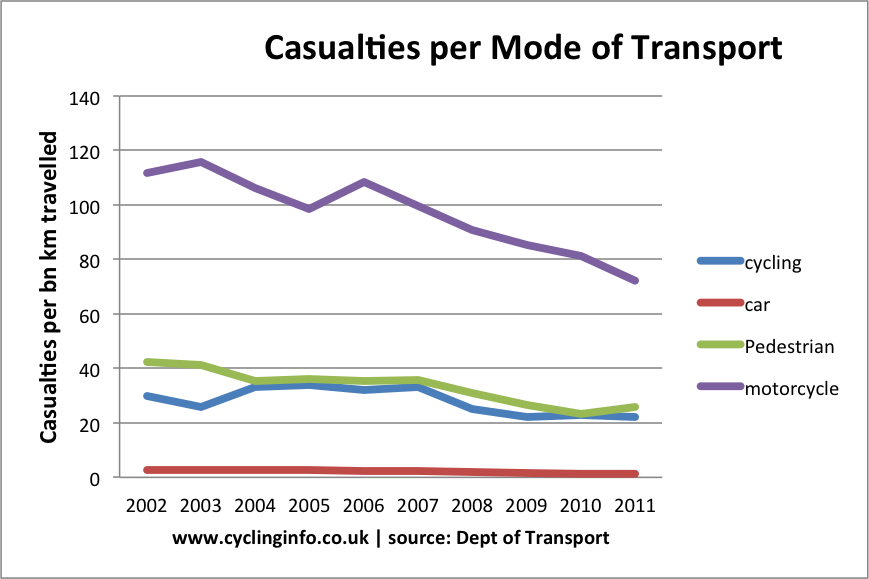
Cycling is often perceived as a dangerous activity and this is often a big factor that discourages people from cycling. The potential dangers of cycling are highly visible and road users can feel vulnerable when facing fast moving traffic on both urban and rural roads. However, despite some fears about dangers of cycling, it is still a relatively safe activity.
When evaluating the dangers of cycling, the most useful metric is looking at accidents per bn km. By this measure, cycling is more dangerous than travelling by car or train, but it sill shows that fatal accidents are very rare – compared to the amount of cycling undertaken.
In this regard, cycling is no more dangerous that similar activities such as DIY, gardening or even walking through an urban environment. Also, worth bearing in mind are the health benefits of cycling. Cycling can play a key role in reducing deaths related to obesity and heart problems. These killers are less obvious than the dangers of cycling, but they are just as important in determining life expectancy.
BTW: I was inspired to revise this post because I got an invite to speak on Aljazeera TV on the dangers of cycling in the light of Bradley Wiggins’ recent accident near Wigan.
Some Basic Cycling Statistics
- The number of cyclists killed on British roads in 2011 was 107 – down from 132 in 2007.
- The total number of people killed in road traffic accidents during 2011 was 1,901 people – down from 2,946 in 2007.
Other Fatalities in UK
- The number of people who died of heart disease in the UK in 2007 was 70,000
- The number of people who died using a ladder was 50. [1]
Cycling vs Other Modes of Transport

In the past decade, there has been a rapid improvement in road safety, with a sharp drop in road fatalities. However, the drop in cycling fatalities has been much slower. Serious cycle accidents have actually increased. This partly reflects the fact that cars have gained improved safety features such as crumple zones and air bags, and these technological improvements are obviously not applicable for cyclists.
Casualties per km travelled

The most useful way of measuring the dangers of cycling is to look at accidents per km travelled. In the UK, in 2011 there were 21 fatalities per billion km travelled. This is down from a fatality rate of 44 per billion km travelled in 1990.
- In the Netherlands, there were 9 fatalities per billion km cycled in 2009. SWOV rates in Netherlands.
- In the UK there are 21 fatalities per billion km cycled.
However, the fatality rate for cyclists is nearly 17 times higher than cars. In 2011, the fatality rate for car users was only 1.2 per bn km travelled.
Risk Decreases the More People Cycle.
Cities with a higher density (%) of people cycling tend to have lower mortality rates. For example, in 1994, London had 19 fatal cycling accidents. In 2007, the number of cycle journeys had increased 91%, yet, fatalities fell to 16. This is a small sample, but, it suggests that as more people cycle, motorists adjust their behaviour to compensate for the increase in number of cyclists.
- In countries like the Netherlands, where cycling takes more than 30% of all journey, fatalities are a much smaller % of total km travelled.
- The UK sees less than half the cycling fatalities per 100,000 people than in Germany. However, Germans make five times as many journeys by bike as Britons. [BBC]
Cycling vs Other Forms of Transport
| Odds of Death vs. Injury in Crashes by Vehicle | |||
|---|---|---|---|
| Vehicle | Deaths | Injuries | Odds |
| Bus | 17 | 17,000 | 1 in 1000 |
| Car, Station Wagon | 21,969 | 2,378,000 | 1 in 108 |
| Pickup, SUV, Van | 10,224 | 768,000 | 1 in 75 |
| Bicycle | 813 | 58,000 | 1 in 71 |
| Large Truck | 717 | 31,000 | 1 in 43 |
| Motorcycle, Motorbike | 2,106 | 54,000 | 1 in 26 |
| On Foot | 5,307 | 77,000 | 1 in 15 |
| Data From NHTSA Traffic Safety Facts 1997 | |||
This graph comes from US.
I have seen various different data on the risk of cycling. But, this seems a comprehensive study about the relative dangers of different types of transport. Cycling is more dangerous than driving a car or going by bus. But, it is less dangerous than being a pedestrian. [link]
Cycle Death rates by mode of Transport UK

Fatalities per bn Kilometres travelled. Death rates by mode of transport
Health Benefits of Cycling
Although cycling incurs a certain risk, it is definitely worth mentioning the advantage of cycling in improving fitness. Cycling helps to improve aerobic fitness and reduce obesity. This makes a significant contribution to reduce heart disease and other obesity related diseases. The number of deaths from heart disease in the UK is a staggering 70,000 a year. This easily dwarves the fatalities of cycling (126). Whilst a cycling accident makes a newsworthy story, a heart attack doesn’t. But, it is important to weigh up the benefits as well as the cost. Yet, in deciding whether to cycle or drive, most people tend to focus on the dangers.
see more on: Cycling and health
Summary – So Is Cycling Dangerous?
Like any activity, cycling incurs dangers. However, they are not unreasonable dangers compared to other activities. Overall, cyclists may still expect to live longer than non-cyclists because the benefits from increased physical health outweigh the fatalities resulting from road traffic accident.
Often cycling accidents make headline news, creating a media sensation which highlights the dangers of cycling. For example, a death from DIY activity or heart disease would be unlikely to make local papers, but a cycling accident (especially if involving a top cyclist like Bradley Wiggins would.)
However, despite cycling being relatively safe, it could still be made much more safe. Improvements in road safety in the past decade have proportionately benefited motorists. Cycling could be made a safer activity through extending 20mph speed limits, better road design and improved driver and cyclist awareness.
When evaluating the dangers of cycling it is important to treat statistics and headlines with caution. London cycling fatalities may have increased in recent years, but this has to be set against a rapid increase in cycle use. The Netherlands may have more actual fatalities than the UK, but cycle rates are far higher. The most useful statistic is to set cycle accidents against rate of use. Per bn km is not ideal (e.g. long motorway journeys are statistically much safer than short urban journeys) but it is better than raw data.
Related
- Cycle safety
- Cycling Dangers – perceived and Real
- Safety accessories at Evans Cycles
- Cycle Death Rates by Country
- Deaths of Cyclists in London at BMJ
- Cyclists live longer at Dave Moulton’s blog

I have been cycling on Norfolk roads for 6 years now (15 miles per day, 6 days per week) and I have to say that they are getting more dangerous. I used to cycle regularly on the Holt Road, but I have had to stop after many near misses. Most of my near misses have occurred when a vehicle (size doesn’t seem to be an issue) is late in adjusting for the over taking manoeuvre. I have experienced both family cars and lorries that seem to aim at at my back wheel as a guide as to when to start their swerve and many are still adding to their distance from me well after my front wheel. If only they could adjust they position prior to the point of overtaking the whole process would be potentially less dangerous for both parties.
Using the Holt Road in Norfolk as a straw poll, I would say that the biggest culprits for this are Vans, Trucks and Larger Cars (My particular bane are cars with low profile tyres, which make them sound positively deadly as they approach and skim my elbows when passing).
Another dangerous situation that occurs regularly on Norfolk roads is [what I would call] the ’3 car dash’. My latest one of these was at around 4pm on the Reepham Road heading out of Reepham towards Norwich, along a particularly straight [and potentially fast] stretch of road. I was ahead of 3 vehicles (unknown at the time), the first (a van) over took me with about 100 meters of clear road between them and oncoming traffic (a small car). The road is single lane in both direction and without any centre line or side line markings. The second car followed in the slip stream of the first vehicle with around 35 meters of clear road before the oncoming car reached us. The first time that I realised that the third car was also going to try and follow its predecessors was when I heard the screams coming from within the oncoming car (windows open). Screeching of breaks and a quick look over my shoulder to see a man in his late 20′s looking scared, shocked and somewhat intimidated by the swearing 6ft, 16 stone cyclist that he very nearly killed with his stupidity.
I just felt that I had to write to say that most incidents involving cars and cyclists are not caused by the cyclist. The vast majority of reporting on these incidents insinuates that the blame lies with both parties equally, but this is not true outside of cities. On countryside roads, which are broadly speaking less wide than most city roads, the cyclist must be treated as a equally important vehicle and not, as is happening, some annoying bollard for the cars and lorries to whoosh past as closely as possible. Country roads suffer from pot holes, cracking edges and cambers. Bicycles can’t ride out the lumps and bumps that cars take for granted, they have to swerve.
I’ve often seen motorists follow other cars blindly – like the Leeming effect
You must have a look at this link on the BBC website today (1/2/11) http://www.bbc.co.uk/news/uk-12334486
One of the biggest threats to cyclists is potholes. They damage cycles and cyclists, and they force you to swerve in front of traffic/pedestrians at the last moment and make you focus on the area of the road immediately in front of you, when you need and should have a greater perspective of road and traffic conditions.
Most councils don’t do enough because it will only become cost effective for them to repair the roads properly when compensation claims exceed the cost of repairs.
I am a keen cyclist but I am sorry to say that this article is just very poor propaganda. As others have mentioned, the statistics bear little or no relationship to each other.
Furthermore to compare the UK with the Netherlands is like comparing chalk and cheese. The Nederlands have invested widely in cyle lanes and not of the very poor type found in the UK which are on the same piece of tarmac as the car only separated by a painted line…that’s great protection isn’t it?
The clear facts are that cycling is an increasingly dangerous activity overall for two main reasons -
1. Car drivers are becoming increasingly distracted and not really bothered about how they drive and what the conseqences are. Hitting another car is bad enough but survivable. Hitting an unprotected cyclist or pedestrian is almost sure to be a disaster…for the one being hit.
2. Cyclists are increasingly becoming unthoughtful and uncaring towards other cyclists, pedestrians and also make a big nuisance of themselves to car drivers, many flouting rules such as cycling through traffic lights, not having lights on their bikes, etc. Of course far from everyone, but more and more.
This silly bit of PR above really treats people as naive children and it should be replaced with something more realistic that promotes the benefits of cycling but gives some meaningful statistics and advice on how cyclists should behave and what measures they should take to make themselves more visible and careful to avoid careless and negligent drivers who will continue do whatever they do regardless of whatever advice is dished out to them.
I’m so glad somebody did point out that those statistics are actually irrelevant. They are not correctly correlated to each other. I cycle the streets of Johannesburg S.A.
It’s so insanely dangerous that I am usually adrenalised for most of any given distance.
Let’s face it. When people climb into cars something happens to them and they no longer treat people who are not in cars with the same level of respect. As if they sort of ‘become the machine.’
Let’s start a petition to ban cars. Just see, how many people could we get?
Great article. You’re right about people tending to focus on the dangerous aspects of cycling. I’ve been cycling for over thirty years without any real problems. I’ve fallen off my bike a few times because of ice, but I knew the risks before I set off knowing there was ice about.
There’s a risk eliment ineverything we do, you can’t eliminate risk totally, it’s a part of life. Cycling is really no more dangerous than other every day human activities.
These numbers are fairly meaningless, as there are far less people cycling than driving/being passenger of a car.
What we need to know are accidents per cyclist and per car occupant, or per distance travelled.
it’s a very interesting statistics.Here in Russia we have a copy-cat situation.Only much-more motorists,and far-less cyclist.It’s true,’car-owners’ spoils your day.
It’s a very intresting statistics.Here in Russia we have allmost a copy- cat problem. Only much more less cyclist and far-above motorists.In such numbers as today they are the absolute Evil. They\’car-owners’\ spoils your day. Smoking and Fat!
I would say that the more cyclists there are, the less likely you are to be killed or injured if you cycle. The reason being that drivers tend to modify their behaviour the more cyclists there are.
Also, I am guessing that the mortality rate among cyclists is probably caused by collision with a car or some other vehicle, rather than collision with another cyclist.
Cars are the real menace rather than bicycles.
cycling , its not dangerous its just the lunatics in cars who make it so!!!!
Ahhh, just scrolled down and saw precisely where they are from!!
Your statistics make interesting reading. Where are they from? it does put things into a healthy perspective. Thank you